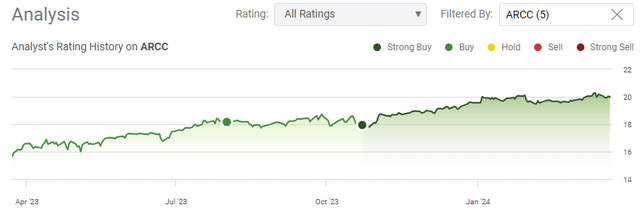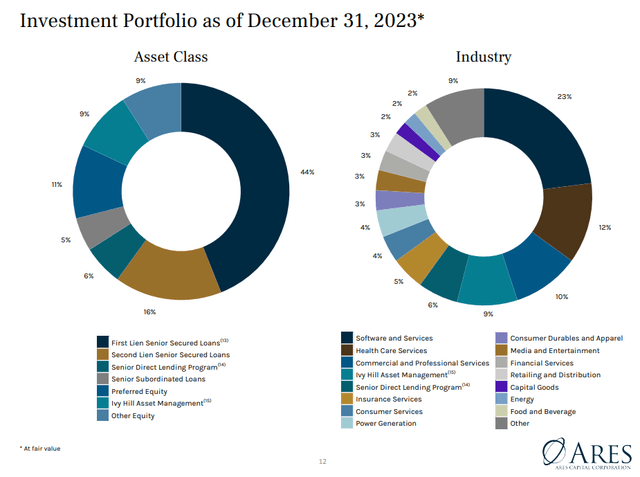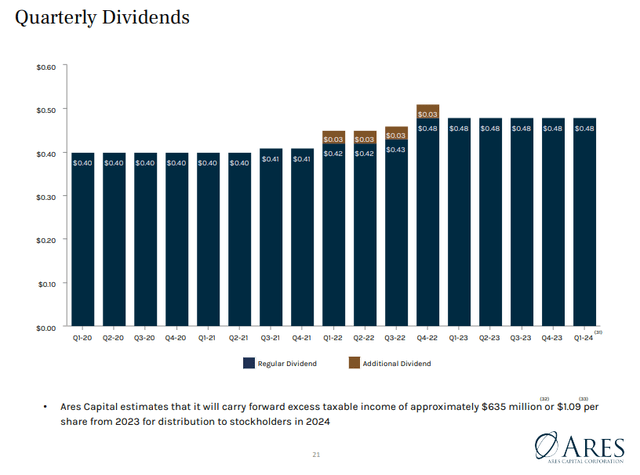PM Images
One of the big questions is what will happen to business development corporations (BDC) when the Fed starts its rate-cutting cycle. BDCs have become increasingly popular during the rate-hiking cycle as they generate larger returns for their shareholders and higher yields from their distributed income compared to risk-free assets. I think many of the popular BDCs will do well in a lower-rate environment, especially Ares Capital (NASDAQ:ARCC), often called the gold standard in the BDC realm. Rates remain at multi-decade highs, and the cutting cycle isn’t expected to reach 3% until after 2026 is finished. I don’t think now is the time to abandon quality BDCs, especially ARCC. Historically, ARCC has maintained a large dividend throughout different rate environments, and I believe that a rate environment that slowly declines could be beneficial for ARCC as the cost of capital decreases and the opportunity to expand becomes more enticing for lower and middle market companies. I think top-tier BDCs will remain strong income investments and could see an influx of investors as capital flows back into the markets from the sidelines. ARCC may not be as good of a buy today as it was last year, but I am still bullish on ARCC as an income investment and look forward to reinvesting the dividends and increasing my position in 2024.
Following up on my previous article about ARCC
I have been bullish on ARCC for some time and gave ARCC a very bullish rating in my last article, which was published on 10/22/23 (can be read here). Since then, shares of ARCC have appreciated by 7.01%, and when the dividend is factored in, the total return is 12.21%. ARCC has trailed the S&P 500 returns of 24.32%, but it’s not in competition with the market. In that article, I discussed why I was a buyer going into Q3 earnings and why I thought ARCC could continue to benefit from the current state of interest rates. I am following up on this investment idea as a significant amount of macroeconomic data has been released, and we have a clearer picture of where rates will be going in the future. I will look at how ARCC finished the 2023 fiscal year and give my opinion on why I am bullish on ARCC entering into a declining rate environment.
Risks to my investment thesis on ARCC
ARCC will either remain a strong investment or deteriorate based on its underwriting ability. The biggest risk to the investment thesis with ARCC isn’t when rates will decline or how quickly they will fall, it’s whether their investments hold up. As a BDC, ARCC takes an equity stake in companies or lends capital to companies in the lower and middle markets in the form of different types of debt. If the companies ARCC underwrites loans to or takes an equity stake suffer unexpected losses or a shift in the business environment occurs, causing them to not perform as expected, ARCC could be seriously impacted. The ability to make interest payments and pay back their loans comes into question, and the equity becomes less valuable than what they have acquired. ARCC is only as strong as the companies it’s doing business with and how well its underwriting team can model the future landscape. If we head into a recession that ends up being extended for a period of time, the companies that ARCC is doing business with are more at risk than large caps, and this could impact ARCC’s returns. Investing in ARCC could generate capital appreciation and large dividend yields, but there are significant risks because the overall economy is unpredictable, and a lot of trust is being placed on ARCC’s team to enter into strong deals that can mitigate downturns if they occur.
ARCC finished 2024 strong and I believe it can continue its financial strength in a declining rate environment
2023 ended up being ARCC’s strongest year over the past decade. ARCC generated $2.61 billion in revenue and after its operating expenses were factored in, its operating profit was $1.87 billion. The bottom-line profit for ARCC after interest expenses and taxes amounted to $1.52 billion in net income. ARCC operated at a 71.46% operating margin and a 58.23% profit margin for their 2023 fiscal year. ARCC grew its revenue by 24.71% YoY, while its operating income grew by 16.6% YoY. 2024 marked the 3rd consecutive year of top-line growth as it continued to drive its metrics higher. On a per-share basis, ARCC delivered $0.72 per share of GAAP net income in Q4 of 2023. Its core EPS grew to $0.63 per share from $0.59 per share in Q3 2023. On an annualized basis, ARCC generated $2.37 in core EPS for the 2023 fiscal year, which was an increase of $0.35 (17.33%) YoY, while its net asset value (NAV) increased from $18.40 to $19.24.
In 2023, ARCC’s portfolio grew to 505 borrowers, which is an increase of 8% YoY and 47% over the past 5 years. Only 2 of their investments exceed 2% of the portfolio, and the top 10 investments represent 12% of ARCC’s portfolio at fair value. Throughout 2023, ARCC derived roughly $6 billion in new investment commitments across 200 transactions. In Q4, ARCC secured $2.4 billion in investment commitments from 74 borrowers, which indicated that the origination market in which they operate is still healthy. ARCC collected 99% of its contractual interest from its underlying investments throughout 2024, which is a testament to its underwriting team. This allowed ARCC to generate $1.27 billion in net investment income (NII), and when the net realized and unrealized gains were factored in, its net income was $1.52 billion.
The Fed didn’t start raising rates until Q1 of 2022, and there was almost a 2-year period in which rates were 25 bps. The Fed took rates from 25 bps to 550 bps over a year and a half. In 2021, ARCC generated $1.82 billion in revenue and $1.14 billion in operating income, coming off rates that were basically non-existent for more than half of 2020 and all of 2021. ARCC has 69% of its interest income tied to floating-rate debt and 12% tied to fixed-rate debt. The average yield on its debt and other income-producing securities is 12.5%. The Fed is projecting that rates will decline to roughly 460 bps in 2024, 360 bps in 2025, and 310 bps in 2026. There is a long runway for ARCC’s investments to generate large amounts of investment income, and they have been able to issue fixed-rate debt at the highest levels in decades. Rates are not expected to fall under 300 bps until at least 2027, and ARCC will continue to originate loans at these levels. In the future, I believe that ARCC could actually do better than their 2023 results because it will become a volume game. Businesses will be more likely to expand as the cost of capital declines, and ARCC could see an influx of originations, which could drive higher levels of NII. The companies that ARCC has equity investments in may also do better, causing the fair value of ARCC’s equity investments to increase. The Fed isn’t expected to cut rates as quickly as they increase them, and I don’t believe a rate environment that is slowly declining will negatively impact ARCC.
ARCC can continue to be an income champion for investors
During a rate environment that was basically non-existent, ARCC didn’t slash its dividend, in fact, it increased it. In 2021, the quarterly dividend increased from $0.40 to $0.41, and in 2022, ARCC bumped the quarterly dividend all the way up to $0.48 while paying special dividends each quarter. Today, shares of ARCC trade for $19.99, and the annual dividend of $1.92 has a yield of 9.6%. ARCC’s dividend income was able to be relied on during the pandemic and throughout a low-rate environment. I expect that ARCC will continue to be a high dividend payer especially since BDCs can avoid paying corporate taxes if they are distributing at least 90% of their taxable income through their dividend program. The $0.48 quarterly dividend is currently supported by $0.60 of NII per share and $0.63 of core EPS. There is more than enough room for ARCC to continue paying out the current dividend.
There is currently $6.36 trillion sitting on the sidelines in money market accounts without taking into consideration capital tied to CDs and T-bills that will be maturing over the next year. As the risk-free rate of return starts to decline, I think BDCs will become more popular as an alternative to the T-bill and chill methodology for generating income. ARCC is considered the gold standard because it has the largest net assets and generates the largest amount of NII in the BDC sector. As rates start to fall, I think a fair amount of capital will find its way back into the equity markets, and we will see income investors looking to recreate their yields through a combination of investments, which will include BDCs. I believe ARCC will be at the top of the list as its dividend track record resembles stability, and when investors look into the underlying financials, it seems as if ARCC is in a good position to maintain the dividend at its current level.
Comparing ARCC to its peers
I track 12 BDCs so I can compare how the peer group is trading and how any individual BDC is being valued. The peer group that I will compare ARCC to consists of the following BDCs:
- Main Street Capital (MAIN)
- Prospect Capital Corp. (PSEC)
- Barings BDC (BBDC)
- Blue Owl Capital Corporation (OBDC)
- MidCap Financial Investment Corporation (MFIC)
- Goldman Sachs BDC (GSBD)
- Oaktree Specialty Lending Corporation (OCSL)
- Golub Capital BDC (GBDC)
- FS KKR Capital Corp (FSK)
- Gladstone Capital (GLAD)
- Sixth Street Specialty Lending (TSLX)
ARCC is the largest BDC by NAV, and by the amount of NII it produces. I always want to pay a great price for a BDC’s NII, but I do believe a premium should be placed on great companies. Today, ARCC is generating $1.27 billion in NII and trades at a market cap to NII multiple of 9.58x. This is a premium on the peer group average of 8.1x. Of the 12 BDCs I track, only 3 of them generate over $500 million in NII, so paying slightly higher than the peer group average for ARCC is justified, in my opinion. I am comfortable with where ARCC is trading and feel it deserves a bit higher premium due to its quality.
Steven Fiorillo, Seeking Alpha Steven Fiorillo, Seeking Alpha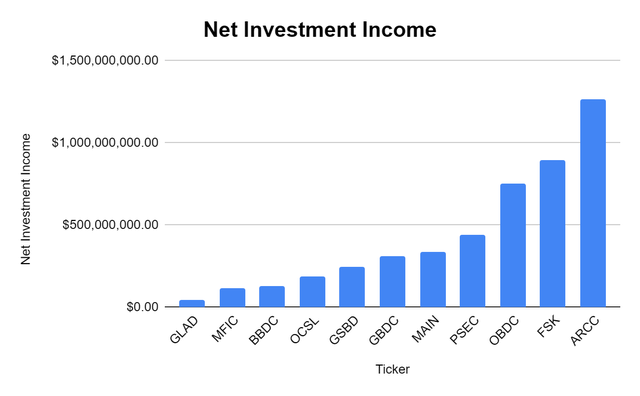
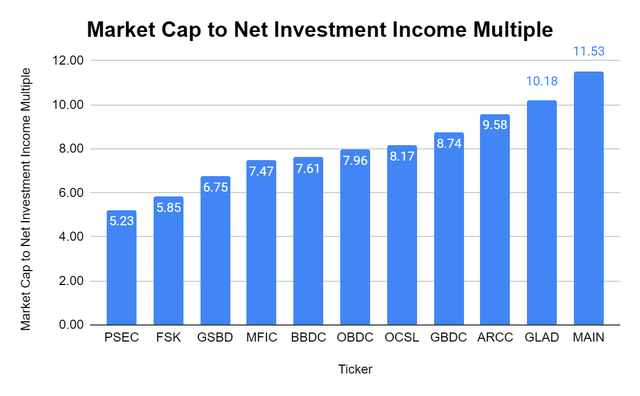
In addition to the market cap to NII multiple, I always look to see how much of a discount or premium a BDC is trading at compared to its NAV. ARCC trades at a 3.9% premium to its NAV compared to a peer group average of a -0.66% discount. When I see that BDCs such as MAIN continue to trade at more than a 50% premium to its NAV it makes me feel good about ARCC’s premium. I think a 3.9% premium is justified, and I wouldn’t be surprised if it traded between a 5-10% premium in the future.
Steven Fiorillo, Seeking Alpha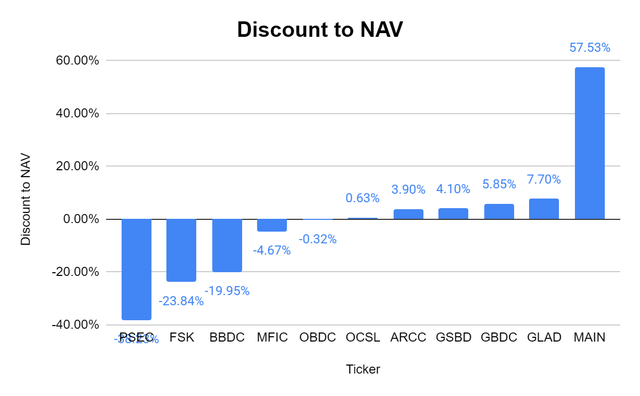
BDCs are known for generating large dividend yields, and ARCC currently has a dividend yield of 9.6%. While this is under the peer group average of 10.57%, I don’t have any complaints about an investment coming with a 9.6% yield. I think some of the BDCs with double-digit yields are undervalued, and that contributes to ARCC being under the peer group average.
Steven Fiorillo, Seeking Alpha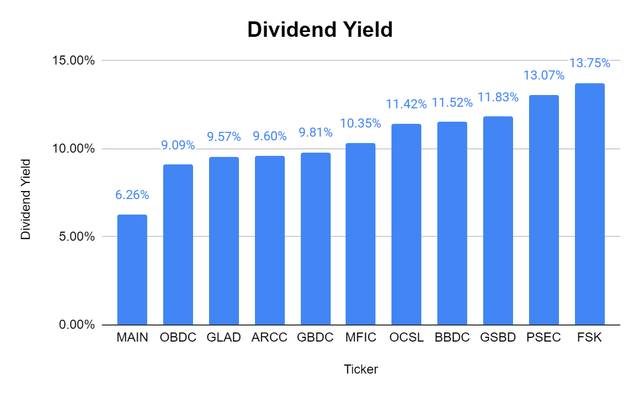
Conclusion
Despite ARCC being up 15.58% in the past year, I think shares are still a buy for income-focused investors. The probability of ARCC outperforming the market is slim, but its ability to continue generating $1.92 per share in dividend income looks safe compared to its core EPS and NII. I think shares of ARCC will trend higher over the next year, and going into a declining rate environment won’t be detrimental to the investment thesis. Today, investors can lock in a 9.6% dividend yield on cost while shares trade at a slim premium to NAV. As we enter into a rate-declining environment, I think the top-tier BDCs will become magnets for capital looking to recreate income from the T-bill and chill movement. I am long ARCC and still feel it’s an opportunity to generate larger-than-average yields and capital appreciation.

